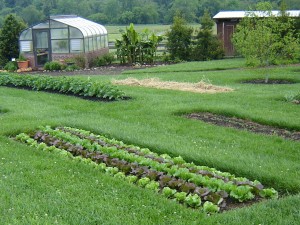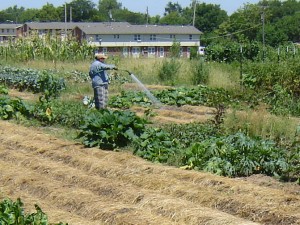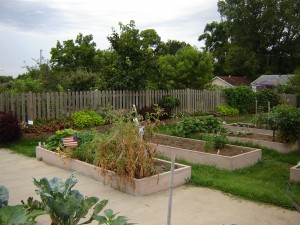Shawn Banks: Extension Blog Contributor
Johnston County Extension Agent/Educator
North Carolina State University
shawn_banks@ncsu.edu
As an extension agent one question I often get asked by new gardeners is, “Where do I put a vegetable garden in my yard?” That leads to a lot more questions, but let’s answer the where question first. There are four basic considerations when selecting a garden site.

The first thing to consider is the need for direct or full sunlight. Most vegetables need a minimum of six to eight hours in order to produce a crop. However, the more sunlight they get the more bounteous the harvest will be. If there isn’t a spot in the yard that receives full sun all day, then the question becomes, is it better to have shade in the morning or in the evening? Morning sun will dry the dew from the leaves, reducing the chance of fungal diseases infecting the leaves.
 Speaking of dew, the next consideration is water. How close is the water source to the vegetable garden. Many vegetables need to have consistent moisture. That means a water source should be easy to access to keep the soil moist throughout the growing season. The further the water is from the garden, the less likely it is that the garden will get watered on a regular basis. Have you ever wondered why the tomatoes crack, or the radishes split? One of the most common reasons is that the soil was very dry and then it rained a lot and the plant was trying to store as much water as possible, causing the cracks and splits
Speaking of dew, the next consideration is water. How close is the water source to the vegetable garden. Many vegetables need to have consistent moisture. That means a water source should be easy to access to keep the soil moist throughout the growing season. The further the water is from the garden, the less likely it is that the garden will get watered on a regular basis. Have you ever wondered why the tomatoes crack, or the radishes split? One of the most common reasons is that the soil was very dry and then it rained a lot and the plant was trying to store as much water as possible, causing the cracks and splits
 Another consideration is airflow. Many foliar diseases are caused by fungal pathogens. Most fungi need water standing on the leaf for eight or more hours before they can infect the leaf. Good airflow will dry the leaves out before the fungi can infect the plant. A hedge, a solid fence, or even a house may obstruct airflow. Another way to obstruct airflow is to plant too close together, but that is a discussion for another time.
Another consideration is airflow. Many foliar diseases are caused by fungal pathogens. Most fungi need water standing on the leaf for eight or more hours before they can infect the leaf. Good airflow will dry the leaves out before the fungi can infect the plant. A hedge, a solid fence, or even a house may obstruct airflow. Another way to obstruct airflow is to plant too close together, but that is a discussion for another time.
 Lastly comes the phrase “out of sight, out of mind”. This is very true for a vegetable garden. When selecting where to place the garden, consider ease of access. Many people find that when the garden is way in the backyard, they don’t tend it often enough. The soil dries out. The weeds take over. The crops don’t get harvested in a timely manner. In short, the garden doesn’t succeed. Select a garden site that is close enough that you will see it and want to tend to it.
Lastly comes the phrase “out of sight, out of mind”. This is very true for a vegetable garden. When selecting where to place the garden, consider ease of access. Many people find that when the garden is way in the backyard, they don’t tend it often enough. The soil dries out. The weeds take over. The crops don’t get harvested in a timely manner. In short, the garden doesn’t succeed. Select a garden site that is close enough that you will see it and want to tend to it.
These four site characteristics are the most important when selecting the location for a vegetable garden. Remember, a vegetable garden site needs a minimum of eight hours of direct sunlight, consistent moisture, good airflow, and easy access. A site with all four of these characteristics will ultimately produce more, have fewer problems with fungal diseases, and be better taken care of because it is visited more frequently and loved.
Keep in mind that if you don’t have anywhere in your yard that works, many options, such as container gardens, can help you have a productive garden anywhere.
Good stuff Holly!
Love these ideas, they will help me a lot as my garden grows
At some point in the future, could you please address the problems of gardening in cities where trees abound and root competition might be a problem? I used to have the greenest vegetable thumb, other than my grandfather’s, but, after having lived in a long-rectangular urban lot surround by trees that I don’t want to hurt, I have found that my yields have suffered yearly since I first made my vegetable boxes (which sit on the ground). I am about to remove them all and go with pots that can be tipped to remove any intrusive tree roots, but I would love to hear about a solution of which I haven’t thought.
The only solution I can think of is to line the bottom of your raised beds with heavy duty black plastic. As long as your raised beds are made out of wood that allows for drainage between boards/timbers you shouldn’t have a waterlogging problem. And the plastic would keep the tree roots from invading the boxes.
I completely understand that solution, but am I not then still arriving at a similar problem by having to water the plants more frequently because the vegetables’ roots cant dive deep enough? I don’t see how pots wouldn’t be a better long-term solution, since tree roots will eventually grow up over and into the soil on top of the plastic. Then, I would have to cut into the sides of the boxes’ soil to force back the roots (or make them branch even more, or both). Not trying to be contrary. Just frustrated.